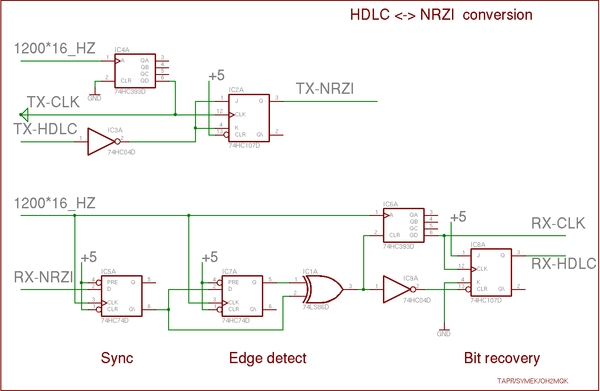Ero sivun ”APRS-AX.25.en” versioiden välillä
Siirry navigaatioon
Siirry hakuun
>Oh2mqk p (typofix) |
>Oh2mqk (Main modulation details.) |
||
| Rivi 9: | Rivi 9: | ||
* The topmost bit on SSID bytes of VIA address fields is "Has been digipeated", and the two reserved ones should be "11", but again nobody validates those two reserved bits! | * The topmost bit on SSID bytes of VIA address fields is "Has been digipeated", and the two reserved ones should be "11", but again nobody validates those two reserved bits! | ||
Primary modulation method: | |||
* NBFM radio on frequency which depends on the continent of operation. 144.390 MHz on USA, 144.800 MHz in Europe, etc. | |||
* FM carries two audio modem tones at 1200 baud bit-rate. Method is known as AFSK. | |||
* Original datastream is at first run thru HDLC encoding, then NRZI encoding, which inverts outgoing bit every time there is zero bit in the original data-stream. | |||
* NRZI datastream produces AFSK tones per Bell-202, 1200 Hz (for bit 1) / 2200 Hz (for bit 0) | |||
Converting HDLC to NRZI (and back) can be done with this circuitry: | |||
:[[Image:Packet-radio-hdlc-to-nrzi-conv.png|600px]] | |||
For preamble before first HDLC flag, there should be at least 16 zero bits, which produce alternating tone pattern, which then quickens bit synchrony detection. | |||
If more than one data packet is sent, the entire time after first data packet's ending flag until next packet's start flag shall be filled with flags, '''not''' zero bits, nor anything else! | |||
[[Luokka:APRS]] | [[Luokka:APRS]] | ||
Versio 2. lokakuuta 2009 kello 17.10
Finnish version is at APRS-AX.25 page
APRS uses variation of AX.25-link-layer protocol, which leaves several of AX.25 protocol details ignored.
Most important differences:
- Three topmost bits on Source and Destination address fields SSID bytes are never validated. Practically any bit values can be used, but recommended version is to use 011 or 111 for both fields.
- VIA address fields (digipeater fields) can be up to 8, AX.25 v2.2 says that there can be up to two.
- The topmost bit on SSID bytes of VIA address fields is "Has been digipeated", and the two reserved ones should be "11", but again nobody validates those two reserved bits!
Primary modulation method:
- NBFM radio on frequency which depends on the continent of operation. 144.390 MHz on USA, 144.800 MHz in Europe, etc.
- FM carries two audio modem tones at 1200 baud bit-rate. Method is known as AFSK.
- Original datastream is at first run thru HDLC encoding, then NRZI encoding, which inverts outgoing bit every time there is zero bit in the original data-stream.
- NRZI datastream produces AFSK tones per Bell-202, 1200 Hz (for bit 1) / 2200 Hz (for bit 0)
Converting HDLC to NRZI (and back) can be done with this circuitry:
For preamble before first HDLC flag, there should be at least 16 zero bits, which produce alternating tone pattern, which then quickens bit synchrony detection.
If more than one data packet is sent, the entire time after first data packet's ending flag until next packet's start flag shall be filled with flags, not zero bits, nor anything else!
